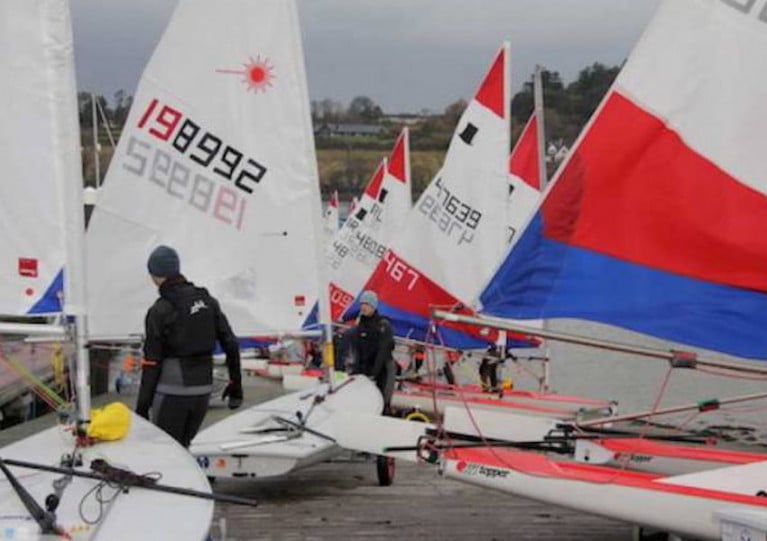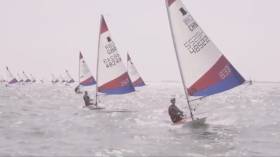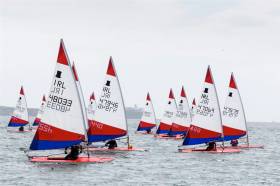Displaying items by tag: Topper Worlds
RYANI Hails Local Topper Sailors’ Success in Worlds and Nationals
RYA Northern Ireland has hailed the success of its junior sailors in the recent Topper Worlds as well as the Irish and British Nationals in the region’s largest junior single-handed class.
In early July, four out of the top five sailors in the Irish Nationals at Ballyholme Yacht Club were from the Northern Ireland fleet — with Cormac Byrne of Strangford Sailing Club in second, Luke Simpson from County Antrim YC in third and Ballyholme YC’s Emily Macafee fifth overall, while in the 4.3 Class, Adam Green of Lough Erne YC placed third.
As previously reported on Afloat.ie, CAYC’s Luke Simpson and Tom Driscoll from the Royal North and Ballyholme provided NI’s best performances at the Royal Cork in the Topper Worlds later in July.
After a long week at the Worlds, only five NI sailors made the trip to Plas Heli Sailing Club in North Wales for the British Nationals last week but again put in a fantastic effort.
Cormac Byrne hit out with an incredible first day posting a 2, 1, 2 to lead overall, only to then suffer a Black flag in race two and have the scores amended. A tough blow but these things happen in championship racing.
Lighter winds played a part in the qualifying rounds as likely candidates struggled and some even missed the cut for the gold fleet. Consistency would prove invaluable and Like managed the event very well to make the podium in third overall.
With more wind on the last day, others managed to find form, posting several top three results, but after a tough start to the week had to settle for places just outside of the top ten: Tom 12th, Emily 15th and Cormac in 20th.
“Congratulations to our sailors on a great competition season. And hats off to the parents and coaches who supported them and drove them around the country and further afield to realise their goals,” RYANI said.
Topper Worlds Coming To Cork Harbour In 2021
The 2021 International Topper World Championships come to Cork Harbour next year when they’re hosted by the Royal Cork Yacht Club from 24-30 July 2021.
With over 200 sailors from around the world expected, organisers say it will be a great opportunity for Ireland’s younger sailors to compete on the world stage — as well as a showcase of the Royal Cork and its facilities.
Ireland’s Topper prospects will also have a chance to prove their mettle the following weekend at the other end of the island, as Ballyholme Yacht Club hosts the UK Topper Nationals from 2-6 August 2021.
The news will also come as a boost to Topper sailors disappointed by last month’s cancellation of the National Series due to coronavirus restrictions, though it’s hoped a number of regional friendlies can be arranged for August.
Details on the official launch of next year’s Topper Worlds are coming soon.
Royal Cork Makes Strong Showing At 2019 Topper Worlds
A top five finish for Royal Cork’s Cillian Foster in the 5.3 was the best of a number of strong results for Irish youth sailors at the Topper Worlds in Medemblik, Netherlands last weekend.
Fellow Royal Cork sailor Neil O'Leary also placed in the top 10, at eighth place, while Darragh Collins, Oisin Mc Sweeney and Hugh Lynch placed highly, in 11th, 14th and 16th respectively, among a sizeable all-Ireland contingent that included Zoe Whitford (21st), Colin Crichton (34th), Becky Lowney (39th), Adam Irvin (41st), Eoin Horgan (44th) and Aoife Murphy (48th) in the Gold fleet.
Ireland also had three hopefuls in the Topper 4.2, headed by Royal Cork’s Rian Collins who placed just outside the top 10.
The week saw the crowning of two new world champions, as Yushuo Liao from China was the gold medal winner in the Topper 4.2, while Britain’s Leo Wilkinson came tops in the 5.3.
Full results are available from Sailing.Today HERE.
Update 3.30pm, Sunday 4 August: This article was amended to correct omissions from the list of Gold fleet places.
Irish Sailing Announces Topper Squad For Summer 2019
Irish Sailing has announced its six-strong Topper dinghy squad for competition over the summer of 2019.
Royal Cork Yacht Club sailors Darragh Collins, Oisín Mac Sweeney and Anna Keal will join Dun Laoghaire youths Jacques Murphy of the Royal St George and Adam Irvin of the National Yacht Club, while Becky Lowney of Wexford Harbour Boat and Tennis Club completes the lineup.
The aim of the Irish Sailing Topper squad is to prepare a team for the 2019 Topper World Championships at the Medemblik Regatta Centre in the Netherlands this July.
Their programme will comprise three domestic training camps focused on development, with input from support services such as Sports Med Ireland, Irish Sailing’s partner in strength and conditioning and physical training.
A secondary objective will be teaching these young competitors how a high-performance youth sailing team works both at home and in competition.
Hugo O’Connor Second At Topper Worlds In China
#Topper - Hugh O’Connor of the National Yacht Club took second place among the biggest fleet yet at at the Topper World Championships in Shenzhen, China earlier this week.
Conditions were light and wet with lots of humidity, and with only two races completed in the 5.3 fleet an official world champion could not be crowned.
Despite the difficult sailing conditions, O’Connor topped a list of strong results for the Irish in Shenzhen.
Erin McIlwaine of Newcastle YC finishd as first lady and sixth overall, while the Royal Cork’s Hugh Lynch and David Jones were fifth and ninth respectively.
In the 4.2 fleet, Joe O’Sullivan (RCYC) was the top Irish sailor with a 14th-place overall finish.
Topper World Championships 2011 Preview
Over 250 of the world's top youth sailors are expected to partake in the Irish event which will run from August 15th – 19th and promises some of the closest and most exciting youth sailing ever seen on Dublin Bay.
The Topper is one of the world's most popular youth boats with over 50,000 boats around the globe. It has grown greatly in popularity in recent years because it suits the learner sailor as well as those with ambitions of Olympic medals. Because it is exceptionally light and easy to transport, the National Yacht Club is expecting 150 competitors from other countries to partake.
"We are delighted to be hosting the Topper World Championships next August," said National Yacht Club Commodore Peter Ryan. "It will follow on from the Figaro Race stop-over and reflects that fact that Dublin Bay can cater for top class events for both ends of the spectrum. The Topper is an extremely popular boat with young sailors and a great gateway to sailing so we will be putting all the club resources into making the event an outstanding success."
The Topper was designed by Ian Proctor whose other boats include the ever-popular Wayfarer. It was originally constructed in GRP but this was changed quite early on to an injection moulding construction.
After well over 20 years of continuous production it is the outstanding build quality, durability and innovative design features that have made the Topper a very popular boat. The Topper hull is injection moulded with incredible precision, reaching a level of uniformity quite outside the scope of any other production system, either hand-built or mass-produced in GRP or roto-moulded plastic. The material is polypropylene which has proved to combine strength and flexibility with lightness and longevity.
National Yacht Club to Stage 2011 Topper Worlds
The 2011 Topper World Championships will be hosted by the National Yacht Club in Dun Laoghaire.
The club beating off stiff competition from around Europe to secure this major sailing event. It follows the successful 2010 Topper Worlds held at Lake Garda last August. The news was confirmed by Bill Brassington, President, International Topper Class Association.
Over 250 of the world's top youth sailors are expected to partake in the Irish event which will run from August 15th - 19th 2011 and promises some of the closest and most exciting youth sailing ever seen on Dublin Bay.
The Topper is one of the world's most popular youth boats with over 50,000 boats around the globe. It has grown greatly in popularity in recent years because it suits the learner sailor as well as those with ambitions of Olympic medals. Because it is exceptionally light and easy to transports the National Yacht Club are expecting 150 competitors from other countries to partake.
National Yacht Club Commodore Peter Ryan commented on the announcement: "We are delighted to be hosting the Topper World Championships next August. It will follow on from the Figaro Race stop over and reflects that fact that Dublin Bay can cater for top class events for both ends of the spectrum. The Topper is an extremely popular boat with young sailors and a great gateway to sailing so we will be putting all the club resources into making the event an outstanding success."
The Topper was designed by Ian Proctor whose other boats include the ever popular Wayfarer. It was originally constructed in GRP but this was changed quite early on to an injection moulding construction. After well over 20 years of continuous production it is the outstanding build quality, durability and innovative design features that have made the Topper a very popular boat. The Topper hull is injection moulded with incredible precision, reaching a level of uniformity quite outside the scope of any other production system, either hand built or mass produced in GRP or roto-moulded plastic. The material is polypropylene which has proved to combine strength and flexibility with lightness and virtually everlasting life.


































































